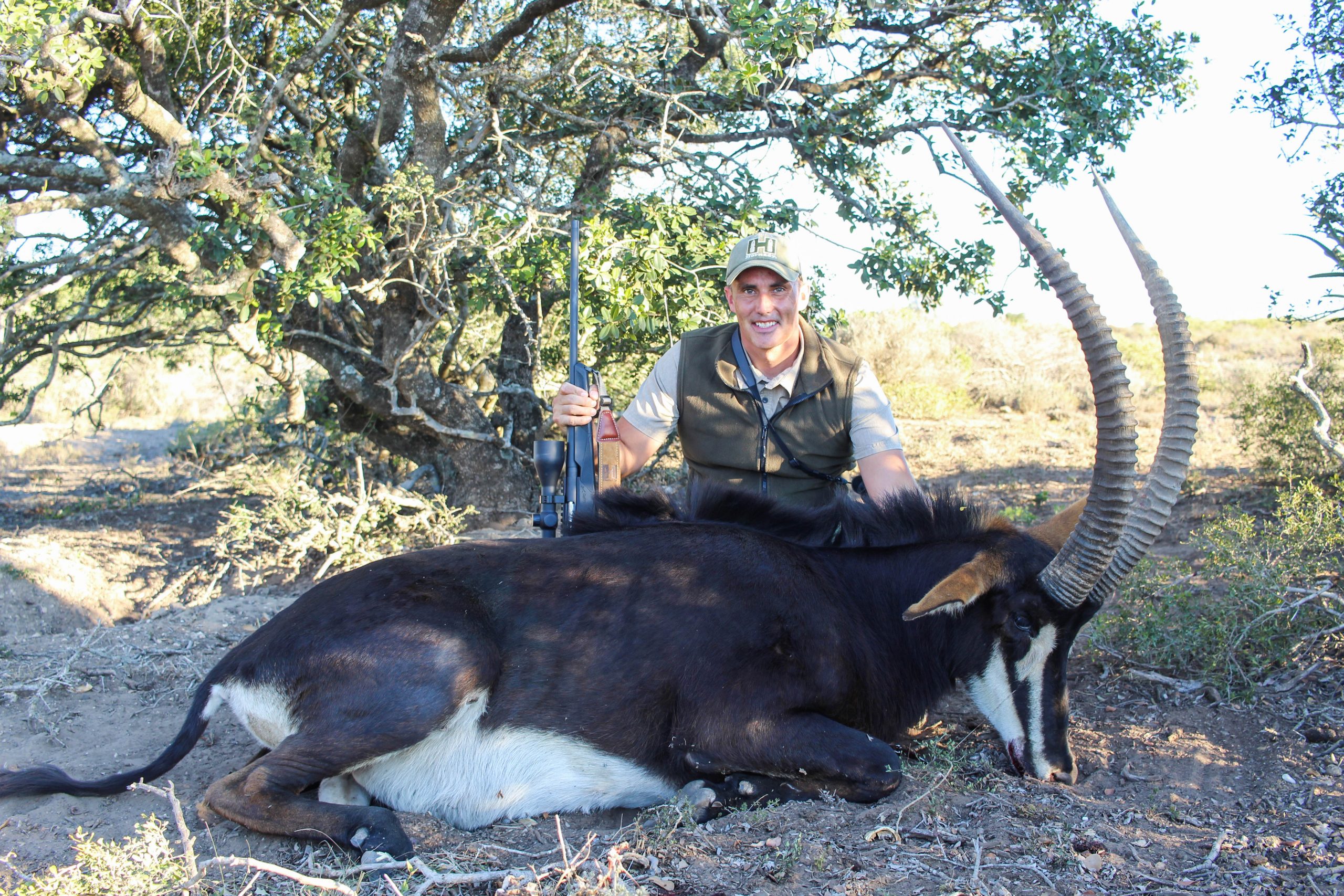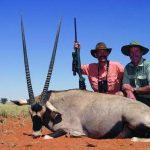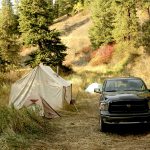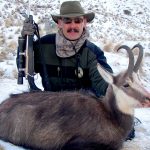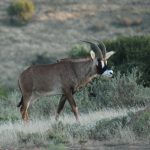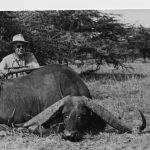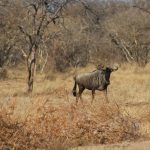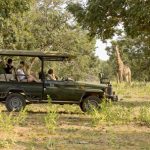Hunting roan and sable antelope in South Africa’s Eastern Cape.
It was midmorning in South Africa’s Eastern Cape when the tracker, Atti, perched on the high seat behind the cab of the Hilux, tapped on the roof. Professional hunter Lambertus “Lammie” Ferreira pressed on the brake, watched Atti’s hand gestures in the mirror, and then killed the Toyota’s engine.
“Sable.”
The two-track dirt road we were following cut a narrow path between forests of coastal Cape thornbush, and in the red dirt I could see the heart-shaped tracks of a sable bull. Atti slipped down from the high seat and followed the spoor, and Lammie and I followed close behind. The bull followed the road for almost a hundred yards, but in a depression the sable veered off and the track led into a tangled mesh of Karoo thorn, plum trees, and prickly pear. This was the end of the line for us.
Drought conditions have plagued southern Africa for a couple of years, but here on the coast, fog from the Indian Ocean provided enough moisture to keep the vegetation thick and green. That heavy cover has made the Doornkom Game Reserve, where I was hunting sable with Africa Anyway Safaris, a haven for a variety of big-game animals. Except for the few dirt roads that weave through the bush and the scattered open areas beaten back by grazing herds of impala, wildebeest, blesbok, and other game, Doornkom is dominated by impenetrable coastal thorn. Our only hope to find the sable was to climb a nearby ridge and glass the cover for any sign of the bull.
Our primary targets on that South African safari were roan and sable antelope, but another objective of the trip was to test Benelli’s new Lupo bolt-action rifle. Benelli’s technical director and the man behind the Lupo, Marco Vignaroli, joined us on the hunt, and Benelli’s Vice President of Marketing, Tim Joseph, was attending as well. I was hunting with Benelli USA Product Manager George Thompson.
While sable and roan were on the top of my wish list, they were not the only animals that we planned to hunt at Doornkom. From a ridge high above where we’d lost the sable Atti and Lammie spotted a herd of impala with a mature ram half a mile away. We drove to a valley still darkened by morning shadows and set off on foot in a semicircular path that led to the high point where we’d last seen the impala herd. Lammie led the way, and at roughly six-and-a-half feet tall, he could see above the fearsome Karoo acacia trees that ringed the open hilltop where we’d last seen the antelope. The diminutive Atti, stopping now and then to look for tracks and to study the thorn bush surrounding us, was overshadowed by the towering PH. Suddenly Lammie stopped, and when he raised his binocular, I did the same. Through them I could see the rust-red rear leg of an impala, and then a head came into view over the crest of the ridge. They were just in front and above us, feeding down from the open ridgetop into the saddle where we were positioned. Lammie set out the sticks and I maneuvered the Lupo into position, sliding the tang safety forward as the ram’s horns crested the hill. As he cleared a ewe, I pressed the Lupo’s trigger. The Hornady .30-06 GMX bullet struck and the impala jumped twice before dropping from sight.
“Something like that,” Lammie said and slapped my back.
The impala was a mature male with a deep saddle and long, wide upright points. It was the second animal taken by the Lupo—we heard over the radio that Marco took a large bushbuck ram on the far side of the property—but it would hardly be the last.

Searching for Sable
Atti and Lammie’s partnership developed under grim circumstances. Following his military service in Angola, Lammie worked as a detective for the Port Elizabeth Police and while he was investigating a brutal murder, he saw an African man squatting underneath a tree outside the victim’s home with a group of onlookers.
“I asked the man if he could track, and he said he could,” Lammie says. Atti followed the murderer’s tracks over the dry earth and led Lammie and the police to a house where the offender was hiding. When Lammie left the police force to become a professional hunter in 1999, he went in search of the Port Elizabeth man who’d helped him track down the killer. Lammie hired Atti as a tracker, and the two have been working together ever since.
That long partnership has made Atti and Lammie a superb team, and when Atti spotted another sable track shortly after I shot the impala, I took the Lupo from its soft case and followed close behind. By midday the sun was high, and even though it was winter the temperature rose to nearly 90 degrees. I shed my fleece vest and slung the rifle, trotting to catch up to the PH and tracker as they followed the spoor. The bull, likely the same one whose tracks we’d cut earlier, walked a quarter-mile down a dirt road before ducking into another tangle of thorns where he’d likely spend the heat of the day. We broke for lunch.
After returning to the field early that afternoon, Lammie spotted an impala ram that he wanted George to try for. Leaving Atti with the truck, we headed out on foot through the still heat of afternoon, startling a trio of ibis that rose on black wings and uttered raucous, nasally calls.
Impala are among Africa’s most alert animals, and the group of rams that we were following seemed to know that they were being pursued. Through the dust and dry heat we continued, trying to intercept the rams in what turned into a drawn out cat-and-mouse game that didn’t end until late afternoon when they finally slipped out of reach. Lammie called for Atti to bring the vehicle and Lammie, George, and I sat in the shade of a clump of plum trees near the crest of a hill waiting for our ride. When we heard the drone of the Toyota’s motor we saw that Atti pointing to the east as he pulled the truck alongside the plum trees.
“He’s seen three sable bulls,” Lammie said after he and his tracker conferred. “Come, let’s try and find them.”
Atti had seen the sable on an open hilltop not far from where the impala chase started, and we fell in line and moved through the acacia bushes as quickly as possible. A black-tipped thorn caught the tip of my elbow, sending a sudden jolt of pain up through my shoulder, but there was no time to stop.
When we finally caught up with the sable it was late afternoon and the bulls were in the open. I saw the brilliant black and white facial markings and one sweeping horn rising above the thorns, but the bulls moved out of sight and we followed, trying to use the available cover to parallel the animals and get set up for a shot. When we finally saw the sable standing in a patch of thorns, Lammie dropped the sticks and I drew a breath. The largest of the three bulls was in the middle and I centered the cross hair of the scope just above the junction of the leg and the chest cavity. In my periphery I saw the lead bull moving and knew that I had to shoot.
The Lupo cracked and the GMX bullet landed just above the place where I’d aimed, hitting the bull hard and staggering him. I cycled the action and we moved again, jogging around fountains of Karoo thorn as we closed the gap. Two of the bulls were visible, running headlong toward the forest. The last of them, the bull I’d shot, stood for a moment under a tree, and then went down.
Sable bulls, with their contrasting black-and-white markings, upright mane, and arching black horns, are among the most breathtaking of all African trophies. As I knelt beside the bull I was overwhelmed by the beauty of the animal and was equally astonished at its toughness. The 180-grain GMX bullet struck right on the point of the shoulder, but somehow the sable had managed to go almost fifty yards. With the sun setting over the forests of the Cape we set him up for pictures and then loaded the bull into the Hilux. It was nearly nightfall and the lights of Port Elizabeth were just visible far in the distance. Beyond the glow of the city lay the vast, dark emptiness of the ocean.
North for Roan
Two days after I took the sable, our hunting party headed north to another property near the town of Graff Reinet. Wolma Kemp, who owns and operates Africa Anyway Safaris, has access to some of the best properties in southern Africa and I would be hunting roan in the mountainous Camdeboo region just north of Graff Reinet. Our first stop on the northward journey was the Graff Reinet Men’s Club, the oldest club of its kind in South Africa that is still in its original location. We stopped there for lunch and I walked into the main bar area, an unforgettable piece of Africana where the walls are lined with pictures from as far back as the Boer War and weapons from that era. Patched holes in the massive hardwood bar are the scars left by officers who, after imbibing, fired their pistols into the wooden bar. The newest of these blemishes is a grey splatter of lead on the wall which has been framed. The date reads 2008.
We stayed at a lodge in the Camdeboo Park near Toorberg Mountain. Some members of our party headed up into the surrounding hills for Cape kudu, while I stayed at a lower elevation and searched for a roan.
Camdeboo lies in the Karoo semi-desert, and in the low plains between the mountains the dry earth was scorched by prolonged drought. Roan favor the broken country along the Karoo’s rivers, which are now mostly dry, and hunting them is a matter of stalking the brushy watercourses to find a mature bull. Wolma Kemp, or simply Kemp, was my professional hunter, and we came across a trio of roan early during our stay in Camdeboo. But the animals were wary and the dry brush and sand made stalking difficult, and the last we saw of the animals was a rising cloud of dust as they galloped out of sight. We decided to leave them and come back another time.
Our second attempt at roan was more successful. We spotted a bull far down a dry river, and his position allowed Kemp and me to drop into the river and use the high banks as cover. The problem was that other animals along the dry rivercourse—impala, duiker, vervet monkeys—burst into full flight as we passed and threatened to ruin the stalk. Kemp and I worked our way slowly down the winding riverbed, stopping periodically so Kemp and his tracker Ricardo could move to the edge of the riverbed and find the roan. After one such pause Kemp turned to me and then turned back toward the bank, pointing at an angle ahead of our location.
“He’s right there,” Kemp said.
I unslung the Lupo and leaned close.
“How far?”
“Just over the hill,” Kemp said. We’d closed to within 200 yards and would have to climb up the steep, shaded bank to get into position for a shot.
The wind was unstable and shifted directions frequently, and it wouldn’t be long before it betrayed our presence to the bull. I followed Kemp up the bank and moved into position behind a spindly acacia. Unlike the bold, black sable antelope, the roan’s dusty brown coat blended perfectly the winter-dry Karoo vegetation, and all I could see was the fringed ear and black and white facial markings as the bull stepped to the edge of a line of acacia bushes. The roan took two more fast steps and stopped on a short hill less than 100 yards ahead of us. Kemp set up the sticks and I slid the Benelli into position. I pivoted behind the rifle, centering the cross hairs just as the roan bull turned and took a step forward. His head was high and his ears were alert. He’d smelled us.
When the bull stepped clear and stopped once more, I aligned the scope and pressed the trigger. Roan are large, powerful antelope—second only to eland in size in Africa—but the GMX landed squarely on the point of the front shoulder with an audible thwack that indicated a solid hit and I saw the effects of the bullet’s impact. The bull’s head dropped as he stumbled forward, and he sank down in the sand.
Tim Joseph had accompanied on my roan hunt, and as we were snapping photos Kemp saw that another roan bull had been accompanying mine. Tim moved forward into position, but the second bull refused to give him a clean shot. Eventually Tim and Kemp followed the bull forward and caught up with the roan. Tim’s shot, through a narrow window of cover, was perfect. By the time the sun set and shadows stretched across the Karoo plains, both Tim and I had trophy roan on the ground.
We celebrated that night with the Africa Anyway team at Camdeboo’s lodge, but eventually the long hours of hunting prompted us to return to our cabins for showers and sleep. When I walked through the double doors into the dark courtyard I was halted by the brilliant glow of thousands of stars stretching across the night sky overhead. I recognized the Southern Cross, and above it the curled tail of the constellation Scorpio. But when I pulled my phone to check the star map I realized that there was a dim constellation between those two, a group of stars first identified by Ptolemy when he mapped the galaxy in the first century BC. It was Lupus, the wolf, taken from the same Latin term from which the Italian term Lupo is derived. It’s rare that a new rifle’s success is written in the stars, but in the case of Benelli’s new bolt gun, that just may be the case.

The Benelli Lupo
There is no shortage of bolt-action rifles from which to choose, but the Benelli Lupo is something different. For starters, it offers unique technology-forward styling by Italian designer Marco Guadenzi with a receiver design that narrows back to front and angular lines on the stock, receiver, and trigger guard. It looks like a modern hunting rifle that’s been sharpened in a wind tunnel—the Ferrari F8 of bolt guns.
The Lupo isn’t just about looks, though, and the real brilliance of the Benelli is the way in which Marco Vignaroli and his team left no stone unturned during design and production. Perhaps the most groundbreaking design element is the incorporation of an aluminum chassis in a hunting rifle. The threaded CRIO barrel is attached to the receiver in a manner so there’s no reaming following manufacturing, and this allows for a high level of consistency and perfect headspacing on each rifle. The Lupo also offers unparalleled modularity, allowing the shooter to adjust length of pull, comb height, cast, pitch, and drop, as well as trigger pull weight. The Lupo utilizes Benelli’s Progressive Comfort recoil reduction system which utilizes interlocking flexible buffers to reduce rearward impact without the eardrum-splitting noise increase associated with muzzle brakes. The CombTech system allows the shooter to adjust comb height and the high-density polymer and leaf spring design softens recoil impact on the face.
Additional features include a six-hole drilled receiver that comes with Benelli mounts (a single-piece metal rail is available as an accessory), a durable polymer stock, ambidextrous tang safety, AirTouch grip, a threaded 22-inch barrel (1:11 twist with four grooves as tested in .30-06) and a narrowed receiver opening that maintains rigidity while still offering enough space to top-load the rifle.
The bolt itself features three locking lugs and a portion of the bolt body has been fluted to reduce weight and friction for faster cycling, and the fluted design also accommodates an extra round in the magazine. The trigger is outstanding and the drop-out polymer magazine is divided and holds five rounds in standard calibers (four in magnums). There are a host of other nice additions like flush-fitting sling studs (with the option to install another stud and mount a bipod), wraparound fish scale checkering on the stock, a comfortably-angled pistol grip, and a flat-bottom forearm with finger groove. The Lupo I tested in .30-06 weighed just under seven and a half pounds.
Is it accurate? My, yes. With Hornady GMX ammo the gun grouped well under one inch for three shots and even kept five shots under MOA at 100 yards. The ergonomics are excellent and felt recoil is noticeably reduced—especially when you adjust the Lupo to fit you. It’s available in .300 Win Mag, .30-06, and .270 Winchester in 2020, but rest assured that more caliber options and configurations will follow. MSRP is $1,699, which is a good deal for what is essentially the world’s first aluminum chassis hunting rifle—especially considering the build quality and accuracy potential. Find out more at benelliusa.com. –B.F.

